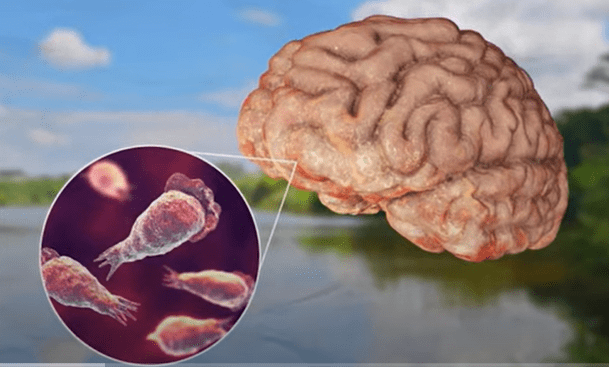Brain Eating Amoeba in Kerala is causing alarm with 70+ cases and 19 deaths in 2025. Learn about Naegleria fowleri symptoms, causes, prevention tips, and Kerala’s safety measures against this deadly brain infection.
Brain Eating Amoeba in Kerala: A Growing Public Health Concern in 2025
Kerala, often celebrated for its backwaters and natural beauty, is currently grappling with a silent but deadly health threat—the brain-eating amoeba, Naegleria fowleri. In 2025 alone, more than 70 confirmed cases and 19 deaths have been reported across the state. This alarming situation has triggered widespread concern among the public and health authorities. While the infection remains rare, its rapid progression and high fatality rate make awareness and prevention crucial.
What Is the Brain-Eating Amoeba?
The brain-eating amoeba is caused by Naegleria fowleri, a microscopic organism found in warm freshwater bodies such as lakes, rivers, ponds, and inadequately chlorinated swimming pools.
- Normally, this amoeba feeds on bacteria.
- Infection occurs when contaminated water enters through the nose, usually while swimming, diving, or bathing.
- Once inside, it travels via the olfactory nerve to the brain, leading to Primary Amoebic Meningoencephalitis (PAM).
PAM is a rare but devastating brain infection that destroys brain tissue rapidly. Without immediate diagnosis and treatment, it is nearly always fatal.
How Does Naegleria fowleri Infect People?
Contrary to common fear, the infection does not occur by drinking water or through person-to-person contact.
Steps of infection:
- Contaminated water enters the nasal passage.
- The amoeba migrates along the olfactory nerve to the brain.
- It begins feeding on brain cells, causing severe inflammation and tissue destruction.
Symptoms usually appear within 1 to 14 days of exposure and include:
- Severe headache
- High fever
- Nausea and vomiting
- Stiff neck
- Confusion and disorientation
- Seizures or hallucinations
The infection often progresses so quickly that death can occur within days if untreated.
The Situation in Kerala
Kerala has reported sporadic cases of PAM since 2016, but in 2025, cases have risen sharply, affecting people of all age groups—from infants to the elderly.
Experts point to:
- Climate change and rising temperatures leading more people to swim in natural water bodies.
- Increased recreational use of freshwater ponds and rivers.
On a positive note, while the global survival rate is just 3–5%, Kerala has achieved a 24% survival rate this year. This success is due to:
- Early detection through advanced laboratory tests.
- Rapid administration of antimicrobials and steroids.
- Improved awareness among healthcare providers.
How Is Kerala Responding?
The Kerala government has launched multiple initiatives to control the spread and impact of the brain-eating amoeba:
- Water safety measures: Chlorination of public wells, ponds, and bathing tanks.
- Awareness campaigns: Educating the public about risks and prevention strategies.
- Technical guidelines: Issued to hospitals for faster diagnosis and treatment.
- Community-level action: Local health departments ensuring water quality in villages.
These proactive measures are helping to contain the outbreak and reduce fatalities.
Prevention Tips for Brain Eating Amoeba in Kerala
While medical advances offer hope, prevention remains the best defense against Naegleria fowleri infection.
Here are some practical safety tips:
- Avoid swimming in warm freshwater lakes, ponds, or rivers, especially after heavy rains.
- Do not allow water to enter the nose while bathing or swimming.
- Use only sterilized, boiled, or properly filtered water for nasal irrigation (e.g., neti pots).
- If experiencing sudden severe headache, fever, or vomiting after swimming, seek immediate medical care.
By following these steps, families and communities can drastically lower the risk of infection.
FAQs on Brain Eating Amoeba in Kerala
Q1: Can drinking water cause brain-eating amoeba infection?
No. The infection only occurs when contaminated water enters through the nose, not by drinking.
Q2: Is the infection contagious?
No. It cannot spread from person to person.
Q3: Why is Kerala reporting more cases now?
Due to climate change, rising temperatures, and increased freshwater recreational activities, exposure has increased.
Q4: What is the survival rate in Kerala?
Unlike the global average of 3–5%, Kerala has achieved a 24% survival rate in 2025 with early detection and improved treatment.
The rise of brain-eating amoeba in Kerala serves as a reminder of the delicate balance between humans and the environment. While the infection is rare, its deadly nature demands awareness, vigilance, and preventive measures. Kerala’s swift medical response and public health strategies have improved survival rates, but community awareness remains the key to reducing future cases.
By adopting simple preventive habits and staying informed, Kerala can protect its people and set an example of how science and public responsibility can work together to fight emerging health threats.
CDC – Brain Eating Amoeba (Naegleria fowleri)
WHO – Water-Related Diseases: Naegleria fowleri
NCBI – Scientific Research on Naegleria fowleri
Kerala Health Department – Official Health Updates
ICMR – Emerging Infections in India
